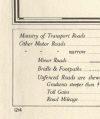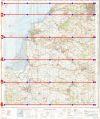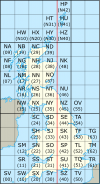SABRE Maps/Coverage projects
| SABRE Maps Coverage projects | ||
| Location Map ( geo) | ||
| Pictures related to SABRE Maps View gallery (46) | ||
| Quick Links | ||
| Coverage Projects overview Fifth Edition • New Popular Edition • Popular Edition • Scottish Popular • Seventh Series • Landranger • Half Inch • Ministry of Transport • Quarter Inch • Ten Mile & Route Planning • OSNI One Inch • 1:25k First Series | ||
| Related Terms | ||
| SABRE Maps Co-ordinate Finder • Sheetfinder Online Grid Calibrator Adding maps in depth Map layer names • Georeferencing | ||
SABRE Maps keeps track of the maps contained upon it as well as the pipelines of maps not yet released within what we call Coverage Projects.
Within them is kept specific information around the map types, such as how they can be dated, as well as tables showing the current coverage of that map type.
Each Coverage Project contains information about the map series contained within; information regarding the projection(s) used; how to date any maps in that series; and a large table containing the exact status of every sheet that we're aware of existing, along with its current status with respect to SABRE Maps. Additional information about how the map status tables work is held below.
How can I contribute?
Do one, more or all of the below!
- Perhaps you have a large map collection already, that you'll be willing to give to us (either permanently or on loan) so that they can be scanned and added to SABRE Maps.
- You might like to scan maps yourself. Most One Inch maps can be done in eight scans on an A3 scanner (four corners and two middles), or a few more scans on an A4 scanner. Just remember to leave a large overlap between the scans so we can stitch them back together, and scan between 300 and 600dpi
- You might wish to involved in stitching the map together, or in georeferencing your maps, or those donated by other people or organisations.
- Or you might be a web developer, and be willing to donate your time and expertise.
- And finally, we have a donations page available to help with the costs of running SABRE Maps, which includes map acquisions, the costs of acquiring map scans from large collections, and web space costs.
Which Coverage Projects are there currently?
Ministry of Transport
The OS Ministry of Transport maps, produced between 1922 and 1936 are probably the single most important historical mapping series from the early days of road numbering within Great Britain, with the initial coverage being to show the brand-new road numbers across the whole of Great Britain. They were then updated during the 1920s to keep pace with the early changes in the network at a time when no other Ordnance Survey mapping carried road numbers.
The importance of the series declined in the 1930s when the OS Ten Mile Road Map of Great Britain became the official series of record, and road numbers started to appear on OS Quarter Inch and OS One Inch Fifth Edition sheets, amongst others. There was a final hurrah following the 1935 changes when a number of maps were reissued.
This series is therefore the highest priority for SABRE Maps to acquire, but many maps were produced in very small quantities, making this challenging.
OS One Inch Seventh Series
The OS One Inch Seventh Series was produced between 1949 and 1974.
This was the first Ordnance Survey mapping at the One Inch scale to be a single series across the whole of Great Britain, and is useful for us to have as it shows mapping at a relatively detailed scale during the major roadbuilding era of the 1950s and 1960s, with the final Seventh Series maps being produced in 1974. They therefore cover the start of the motorway era, and so are very useful for seeing the development of the network, with many details that were later lost documented in map form.
OS One Inch New Popular Edition
The OS One Inch New Popular Edition series was produced between 1940 and 1959, and was the first mapping at the One Inch scale to cover the whole of England and Wales that included road numbers.
The New Popular Edition is useful for us to have as it shows mapping at a relatively detailed scale during the post-war era up to the 1950s, when the One Inch Seventh Series coverage project comes into play. It is also the first mapping at the One Inch scale to fully use the familiar OSGB National Grid.
OS One Inch Fifth Edition
The OS One Inch Fifth Edition series was produced between 1931 and 1941, although a single map of the Isles of Scilly was last reprinted in 1959.
This mapping only covered parts of Southern England, in a complex and confusing array of layouts and styles, but was the first at the One Inch scale to include road numbers.
OS One Inch Popular Edition (England and Wales)
The OS One Inch Popular Edition of England and Wales was printed between the two World Wars, covering a period of surprising growth of the road network of the period, with a number of major projects and small bypasses first appearing here at the One Inch scale.
Whilst it does not contain road numbers, and until 1935 roads were graded by width rather than importance, this is an important series for SABRE Maps to cover in order to show the changing network of the inter-war period.
OS One Inch Popular Edition (Scotland)
The OS One Inch Popular Edition of Scotland was very similar to its counterpart in England and Wales, with one major exception - it continued to be printed after World War 2, with the final sheets being printed in 1956.
These later sheets had the OSGB National Grid printed on them, and also saw the addition of road numbers, similar to that of the New Popular Edition in England and Wales.
OS, OSI and OSNI Half Inch maps
Half-inch maps were the primary coverage of Ordnance Survey maps across the whole of Ireland, and so are extremely valuable to us to show the changes in the road network across the island for many years.
In Great Britain, it's a different story, as non-MoT Half-inch sheets containing road numbers are rare, with a small collection of 1930s National Yard Grid maps, and another small collection produced between 1956 and 1962, plus a Tourist map of Snowdonia being the entire story.
OSNI One Inch sheets
Ordnance Survey Northern Ireland One Inch Popular Edition and One Inch Third Series covered, as the publisher suggests, mostly Northern Ireland but due to NI's shape any rectangular map series also takes in parts of the Republic of Ireland, meaning that this map series also shows the nearby counties in good detail.
These sheets lasted for longer than the equivalents published by OSGB, so there are quite a number of sheets still in copyright as at 2023.
There were a few One Inch sheets published by Ordnance Survey Ireland during this timescale, and these are also covered here.
Quarter Inch and 1:250,000 maps
Quarter Inch sheets were published by all three Ordnance Surveys and intended as "motorists maps", so each show a larger area than one inch or half inch sheets at less detail, but are focussed mostly on the road and railway networks.
In addition, this coverage project covers maps at the metric equivalent of 1:250,000, including modern coverage of the whole of GB thanks to their release as OpenData starting in 2010.
OS Ten Mile Road Maps and similar scales
The first Ten Mile Road Maps of Great Britain was published in 1932 (named after its scale of Ten Miles to One Inch), and was the effective replacement for the MoT map series offering an overview of the road network and numbering across Great Britain. These were then replaced by the Route Planning Map at the 1:625,000 scale which was first published in 1964, and rebrands of this mapping are still on sale today.
Since 2010, Ordnance Survey Great Britain have offered the conceptually similar Miniscale product, which again we have a collection of thanks to it being published as OpenData.
These maps give an excellent overview of the network, and as they were often published at annual intervals they give a good view of the changes year-on-year.
OS 1:25,000 Provisional and First Series
The 1:25,000 Provisional Edition and First Series were first published at the end of World War 2, and some sheets continued to be revised into the 1980s. Whilst these sheets are quite dull-looking in mostly shades of brown and grey, they are valuable in giving a close-in view of the landscape during this period, although care should be taken in using them to date features as their revision was somewhat spotty.
This is the latest Coverage Project to start, and so it is still in its very early phases of completion, with a single mosaic layer currently available which will be expanded into annual layers.
OS 1:25,000 Second Series and Pathfinder
The Ordnance Survey's 1:25,000 Second Series (later rebranded as Pathfinder) were the successor to First Series above. Most sheets are double the size of the predecessor series, and are now dropping out of copyright, having been first published in the 1960s, and continuing in some cases into the 1990s.
OS 1:50,000 and Landranger
The Ordnance Survey's 1:50,000 Series (later rebranded as Landranger) were the metric successor to the One Inch series and are still on sale today.
The first sheets, roughly south of a line between Preston and Hull were first published in 1974, with sheets north of that line being first published in 1976. As these are still in copyright at the time of writing, this Coverage Project is in its preliminary phase of simply gathering information about what sheets are available for us to use when they drop out-of-copyright starting in 2025.
How do the status tables work?
On each Coverage Project, there are large tables that contain information regarding every sheet that we are aware of existing for the map series. The columns of the tables contain the sheet number, the sheet name (where there is one), and then a large collection of columns for each year that maps were printed from that series.
Within the body of the table, where a map exists that was printed in that year it is marked with the appropriate revision or print code that is contained within the map marginalia. Where the map exists but does not possess a revision code (for example, a number of OSI sheets and most first printings of OSGB sheets from the 1920s), this is marked within the table by the code N/A. Where there is no map that was published in the year, the table entry is left blank.
Note that the actual date of a revised printing may be a number of years away from the printed copyright date, and the following ruleset is used for allocating a map to a year, with the first matching rule being used:
- Where noted in an official publication report
- Where it forms part of the revision code
- Where its print date is identified in a publication of the Charles Close Society or one of its members
- Where a copy in a legal deposit library has a relevant date of acquisition stamp
- The latest date printed on the map of any revised features
- The date given of any boundaries printed
- The magnetic date, if later than all other dates on the sheet
- If more than one revision is printed in a year, then the revision closest to the middle of the year is shown in that year, with the "other" revision shifted into the earlier or later year as appropriate
- By elimination from changes shown on the sheet where possible
- By elimination from sheet specification changes including printed pricing and legend layout where possible
- As a "catch all", then once a sheet is in the pipeline or a scan promised it is shown at the mid-point of known revisions
- Sheets which have not been promised and have no known date are not shown
Table colours
As any individual map revision may have a number of different statuses within SABRE Maps, a standard key has been developed and appears above (and sometimes also below) the map tables. These keys are used both for individual map revisions; in the sheet number column for when a full set of revisions for an individual sheet have a status other than "Copy needed"; and likewise in the year column heading for all map revisions printed in that year.
More information about the most common individual colours are as below:
| Available on SABRE Maps | As might be expected, this bright green is shown for maps that are currently live and viewable on SABRE Maps. However, that doesn't mean that we're not interested in acquiring cleaner copies where they're available. |
| Online, but needs replacement source | This deeper green is shown where the copy on SABRE Maps is noticeably dirty, or is missing a section of the map. In other words, where we need a better copy than we have! |
| Unconfirmed Revision | This status colour is used for where in the early days of SABRE Maps, a map sheet was acquired without its marginalia for those map layers where multiple single revisions were combined in the style of the NLS's georeferenced sheets where any revision is used. This is then compared to known revisions to discover which it is, so until confirmation, this colour means "best guess". The vast majority of maps in this status have now been confirmed, so it is now rare to see this on any tables, and it is here for historic reasons. |
| Within the pipeline | Orange means that a scan has been completed and acquired by the Maps team. It may be awaiting georeferencing via the Online Grid Calibrator or it may be awaiting tiling or some other required process. Why don't you take a look at the Online Grid Calibrator to help? |
| Pipeline (Military edition) | Yellow means that whilst a scan has been completed and given to the Maps team, it is of a military edition and not a civilian one. For all standard map series, civilian editions are always preferred to be used. |
| Acquired but not scanned | This status is used to denote where an individual printed map that is out-of-copyright has been either acquired by the Maps team but not scanned by them; or has been promised by someone else. Therefore if you have a map of this revision, and you're willing to scan it and send it to the Maps team, then please do. We're always desperate for help with scanning, so the more that people do for us, the more grateful we are! For in-copyright maps, see the navy colour below. |
| Copy needed | The most simple status of all. We don't have a copy at all of this, and don't know of anyone that does. These are the sheets that we really need people to look through their personal collections to donate! |
| In copyright (copy available) | Whilst we're not allowed to scan in-copyright mapping, that doesn't mean that we can't be ready to go when it does drop out of copyright. This navy colour is used to denote sheets that we cannot scan or publish, but that a copy has been located and promised to us for use. |
| In copyright (copy needed) | The dark red colour is very similar to the white colour above - we don't have a copy and we don't know of anyone with a copy. But this sheet is still in copyright, so really we're looking to locate and have a copy promised to us. |
| No map printed (or empty cell) | Some Coverage Projects use black to denote that no map exists for a particular year. These are usually used for Coverage Projects for map types that only have one or two sheets in them, for example, OS Route Planning Maps; or where there's careful collating of map revisions to produce the minimum number of layers needed to display all revisions, for example, OS Ministry of Transport maps. |
Partner organisations
Under UK and Irish copyright laws, scans of maps hold their own copyright separate to that of any map contained within. SABRE and SABRE Maps takes compliance with copyright laws extremely seriously.
Whilst the majority of individual map scans have been completed by the SABRE Maps team or by individual SABRE members (who therefore hold the copyright on these scans), or by individuals who have released their work into the public domain or with an appropriate re-use licence, a number of map scans have been performed by libraries and other similar organisations who allow SABRE Maps to re-use their map scans either via their standard conditions, or via bespoke agreements.
Note that these organisations hold the copyright on all map scans produced by them, and so SABRE cannot grant permissions for re-use. Further information on permitted re-use of the original scans can be found on the relevant organisation website, and any queries should be directed to them.
Organisations who hold copyright on at least one map scan used within SABRE Maps are listed below:
- Ordnance Survey OpenData
- The British Library
- The National Library of Scotland
- The National Archives
- Cambridge University Library
- The National Library of Australia
- David Rumsey Map Collection, Stanford Libraries
- The Historic Counties Trust
- Perry-Castañeda Library Map Collection, University of Texas
- American Geographical Society Library Digital Map Collection





